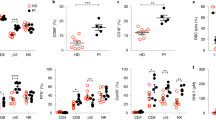Abstract
The distribution ofPlasmodium chabaudi chabaudi AS among normocytes and reticulocytes in the peripheral blood of NIH mice undergoing a primary infection was determined from brilliant cresyl blue/Giemsa's stained thin blood films. During the early stages of infection in normal mice, parasites were found exclusively in normocytes. The presence of parasites in reticulocytes was limited to a period of severe immune pressure on the parasites, peak parasitaemia and the ensuing “crisis” phase, at which time the rapid production of new erythrocytes in response to the anaemia in these mice resulted in a high reticulocyte count. Later, during the recrudescence, parasites inhabited normocytes only. Thus, in immunologically competent animals,P. c. chabaudi AS showed no absolute preference for either mature or immature erythrocytes. In marked contrast, in chronically infected CD4+ T-cell-depleted mice, this malaria parasite apparently displayed a pronounced predilection for reticulocytes. During an unremitting parasitaemia of 2.8%–3.9% during days 13–60 post infection, all parasites were found in reticulocytes, even though these comprised only 25% of the total erythrocyte count. The possible reasons for this reversal in preference for the type of erythrocyte inhabited by asexual malaria parasites are discussed.
Similar content being viewed by others
References
Allan RJ, Rowe A, Kwiatkowski D (1993)Plasmodium falciparum varies in its ability to induce tumor necrosis factor. Infect Immun 61:4772–4776
Brown KN, Berzins K, Jarra W, Schetters T (1986) Immune responses to erythrocytic malaria. In: Britten V, Hughes HPA (eds) Clinics in immunology and allergy, vol 6. W.B. Saunders, London Philadelphia Toronto, pp 227–249
Carlson J, Helmby H, Hill AVS, Brewster D, Greenwood BM, Wahlgren M (1990) Human cerebral malaria: association with erythrocyte rosetting and lack of anti-rosetting antibodies. Lancet 336:1457–1460
Carter R, Walliker D (1975) New observations on the malaria parasites of rodents of the Central African Republic,Plasmodium vinckei petteri sub. sp. nov. andPlasmodium chabaudi Landau 1965. Ann Trop Med Parasitol 69:187–196
Galinski MR, Medina CC, Ingravallo P, Barnwell JW (1992) A reticulocyte-binding protein complex ofPlasmodium vivax merozoites. Cell 69:1213–1226
Jarra W, Brown KN (1989) Invasion of mature and immature erythrocytes of CBA/Ca mice by a cloned line ofPlasmodium chabaudi chabaudi. Parasitology 99:157–163
Jayawardena AN, Mogil R, Murphy DB, Burger D, Gershon RK (1983) Enhanced expression of H-2K and H-2D antigens on reticulocytes infected withPlasmodium yoelii. Nature 302:623–626
Landau I (1965) Description dePlasmodium chabaudi n.sp., parasite de rangeurs africains. C R Acad Sci [III] 260:3758–3761
Landau I, Boulard Y (1978) Life cycles and morphology. In: Killick-Kendrick R, Peters W (eds) Rodent malaria. Academic Press, London, pp 53–84
Langhorne J (1989) The role of CD4+ T cells in the immune response toPlasmodium chabaudi. Parasitol Today 5:362–364
Long CA (1988) Immunity to murine malaria parasites. In: Englund PT, Sher A (eds) The biology of parasitism. Alan R. Liss, New York, pp 233–248
McLean SA, Pearson CD, Phillips RS (1982)Plasmodium chabaudi: relationship between the occurrence of recrudescent parasitaemias in mice and the effective levels of acquired immunity. Exp Parasitol 54:213–221
McNally J, O'Donovan SM, Dalton JP (1992)Plasmodium berghei andPlasmodium chabaudi chabaudi: development of simple in vitro erythrocyte invasion assays. Parasitology 105:355–362
Mons B (1990) Preferential invasion of malarial merozoites into young red blood cells. Blood Cells 16:299–312
O'Donovan S, Dalton JP (1990) Identification of a putativePlasmodium berghei (a rodent malaria parasite) reticulocyte receptor. Biochem Soc Trans 18:338–339
Ott KJ (1968) Influence of reticulocytosis on the course of infection ofPlasmodium chabaudi andP. berghei. J Protozool 15:365–369
Pasvol G, Wilson RJM (1989) Red cell deformability and invasion by malaria parasites. Parasitol Today 5:218–221
Podoba JE, Stevenson MM (1991) CD4+ and CD8+ T lymphocytes both contribute to acquired immunity to blood-stagePlasmodium chabaudi AS. Infect Immun 59:51–58
Poels LG, Van Niekerk CC, Franken MAM, Van Elven EH (1977)Plasmodium berghei: selective release of ‘protective” antigens. Exp Parasitol 42:182–193
Roberts DJ, Craig AG, Berendt AR, Pinches R, Nash G, Marsh K, Newbold CI (1992) Rapid switching to multiple antigenic and adhesive phenotypes in malaria. Nature 357:689–692
Schetters TPM, Van Zon AAJC, Eling WMC (1986)Plasmodium berghei: relative immunogenicity of infected reticulocytes and infected oxyphilic red blood cells. Exp Parasitol 62:322–328
Süss G, Eichmann K, Kury E, Linke A, Langhorne J (1988) Roles of CD4-and CD8-bearing T lymphocytes in the immune response to the erythrocytic stages ofPlasmodium chabaudi. Infect Immun 56:3081–3088
Taylor-Robinson AW, Phillips RS (1992) Functional characterization of protective CD4+ T-cell clones reactive to the murine malaria parasitePlasmodium chabaudi. Immunology 77:99–105
Taylor-Robinson AW, Phillips RS (1994) Th1 and Th2 CD4+ T cell clones specific forPlasmodium chabaudi but not for an unrelated antigen protect against blood stageP. chabaudi infection. Eur J Immunol 24:158–164
Taylor-Robinson AW, Phillips RS, Severn A, Moncada S, Liew FY (1993) The role of Th1 and Th2 cells in a rodent malaria infection. Science 260:1931–1934
Viens P, Chevalier JL, Sonea S, Yoeli M (1971) The effect of reticulocytosis onPlasmodium vinckei infections in white mice. Action of phenylhydrazine and of repeated bleedings. Can J Microbiol 17:257–261
Walliker D, Carter R, Morgan S (1971) Genetic recombination in malaria parasites. Nature 232:561–562
Weiss L (1990) The spleen in malaria: the role of barrier cells. Immunol Lett 25:165–172
Zuckerman A (1958) Blood loss and replacement in plasmodial infections. II.Plasmodium vinckei in untreated weanling and mature rats. J Infect Dis 103:205–224
Author information
Authors and Affiliations
Rights and permissions
About this article
Cite this article
Taylor-Robinson, A.W., Phillips, R.S. Predominance of infected reticulocytes in the peripheral blood of CD4+ T-cell-depleted mice chronically infected withPlasmodium chabaudi chabaudi . Parasitol Res 80, 614–619 (1994). https://doi.org/10.1007/BF00933011
Received:
Accepted:
Issue Date:
DOI: https://doi.org/10.1007/BF00933011




